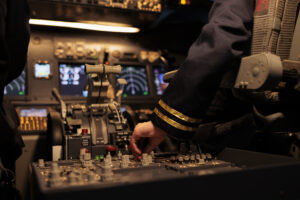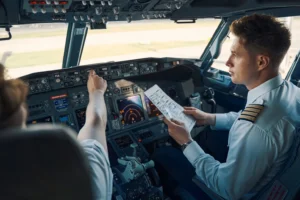Do you also want to become a pilot and soar into the skies? Before you can take off, there’s an important first step: ground class. Ground class is where you learn all the important things about flying while still on the ground. It’s like learning the rules of a game before you start playing.
In this article, we will take a look at why it is important to complete ground training first. We will also provide some essential tips that will be helpful for the students to complete their ground training successfully. So without waiting any further let’s get started.
What is Ground Training?
Ground pilot training is a comprehensive course of learning and practical instruction that prospective pilots receive before actual flight training begins. This phase of training is essential to develop a basic understanding of flight principles and to ensure that pilots are adequately prepared to operate aircraft safely and efficiently Ground training includes flight instruction, legal requirements, operating procedures standards, and aircraft equipment operations
Ground training typically consists of classroom lectures, computer learning modules, practical demonstrations, and high-fidelity simulations This amount of access assures that students understand course content and the practical capabilities needed to fly real-world airplanes situational management.
Key Subjects of Ground Training
- Aerodynamics: Understanding the principles of flight, including lift, drag, thrust, and weight, and how different aircraft designs affect performance.
- Aircraft Systems: Learning about various systems and components of the aircraft, such as engines, avionics, navigation systems, flight controls, and electrical systems.
- Meteorology: Studying weather patterns and meteorological phenomena, and their impact on flight operations, including interpreting weather reports and forecasts.
- Navigation: Learning how to plan and execute flight routes using navigation charts, instruments, and electronic navigation aids.
- Airspace and Air Traffic Control: Understanding different types of airspace, air traffic control procedures, communication protocols, and regulatory requirements.
- Flight Planning and Performance: Developing skills in flight planning, including calculating fuel requirements, weight and balance, performance limitations, and emergency procedures.
- Regulatory Requirements: Familiar with aviation regulations, including airworthiness standards, operational requirements, and licensing procedures.
- Human Factors: Studying factors that affect pilot performance, including physiology, psychology, fatigue management, decision-making, and crew resource management.
- Emergency Procedures: Learning how to recognize and respond to various in-flight emergencies, such as engine failures, instrument failures, and adverse weather conditions.
- Security and Safety: Understanding security procedures, safety protocols, and risk management practices to ensure the safety of passengers, crew, and aircraft.
Why ground training is important for pilots
1. Understanding The Science Of Flight:

Ground training gives a complete understanding of aerodynamics, allowing pilots to appreciate how airplanes acquire and retain flight. This understanding is essential for good airplane control and safe maneuvering in flight.
2. Mastering aircraft systems:

Pilots learn about an aircraft’s complicated systems, including electrical, hydraulic, and navigation systems. This expertise is critical for spotting and fixing possible problems, ensuring that the aircraft runs safely and effectively.
3. Charting Your Course:

Ground training teaches pilots how to navigate the airspace using charts, instruments, and advanced navigation systems. This competence is required for planning safe and effective flying routes, taking into account elements like weather, airspace limits, and fuel requirements.
4. Communicating Like a Professional:

Effective communication with Air Traffic Control (ATC) and other pilots is critical to safety and coordination. Ground training involves proper radio communication protocols and aviation terminology to ensure clear and precise communication during aircraft operations.
5. The Aircraft and Flight Environment:

Pilots learn about different aircraft types and their performance in various weather conditions. This understanding enables educated judgments about takeoff, landing, and navigation, resulting in a smooth and safe flight experience.
6. Improvement of Knowledge and Skills:

Ground training lays the groundwork for continual learning in an ever-changing aviation business. Pilots stay up to date on new technology, rules, and procedures, and they practice maneuvers in simulators to improve their abilities and expertise.
Benefits of ground training beyond cockpit
Ground training has benefits outside the cockpit, improving a pilot’s overall flying ability and safety skills. Teaches a thorough understanding of aviation theory, procedures, and regulations, and improves decision-making and problem-solving abilities in a variety of situations This training for air traffic control encourages communication and successful teamwork by standardized pilot standards for instruction in interacting with other flight attendants.
Ground training also emphasizes the importance of human aspects such as stress management and situational awareness necessary to maintain safety and performance in the air and on the ground.
Tips to successfully complete ground training
- Stay organized and manage time: Create a structured lesson plan with a specific amount of time for each topic. Use scheduling or digital tools to track assignments, deadlines, and change meetings to ensure all topics are adequately covered.
- Participate actively in simulated learning and learning: Participate actively in lectures, discussions and simulations. Ask questions, interact with teachers and peers, and use hands-on activities in simulators to reinforce theoretical skills through practical application.
- Use interdisciplinary learning materials: Include additional resources such as flight textbooks, online courses, study guides, and practice tests in the classroom. The use of different learning materials generates different perspectives and can enhance understanding of complex concepts.
- Join study groups and ask for help when needed: Collaborate with fellow trainees in study groups to share knowledge, discuss challenging topics, and ask each other questions. Do not hesitate to seek help from teachers or counselors when you are struggling with specific issues.
- Focus on health and wellness: Maintain a healthy lifestyle by balancing adequate rest, nutrition, and exercise during classes. Physical fitness and adequate rest are essential for retaining information and performing well in practical tests and research.
Also Read: Tips For Passing The Pilot Written Exam
Conclusion
In conclusion, ground learning is an important part of becoming a pilot. It equips you with the knowledge and skills you need to fly safely and confidently. By understanding how airplanes work, learning weather reports, and learning to communicate with air traffic control, you build a strong foundation for your flight career. Ground class ensures that when you eventually go to the sky, you are prepared for any situation. It is an important first step towards the safety and success of any flight.
FAQ
Can I become a pilot without completing ground class?
No, completing ground class is a mandatory step in becoming a pilot. It ensures that aspiring pilots have the necessary knowledge and skills to fly safely and pass the required exams before advancing to actual flight training.
How do flight simulators help in ground training?
Flight simulators provide a realistic and controlled environment where students can practice flying maneuvers and procedures. They allow trainees to experience various flight scenarios, including emergencies, without the risks associated with real flight, helping them develop crucial decision-making and response skills.
How long does ground training typically take?
The duration of ground training can vary, but it generally takes a few weeks to a few months, depending on the program and the student’s pace. It’s an essential part of the overall pilot training process.
